Upstart actor plays Hamlet
Charles Young was a shining star of the stage and so a huge catch for Newcastle’s Theatre Royal. He had become famous for his performance in Shakespeare’s tragedies, particularly in the part of Hamlet.
The well-educated Young was also famous as an arch rival to that other major Shakespearean actor of the day, the slightly more rough-diamond, Edmund Kean.
-
![]()
Much ado near me
Hear more Shakespeare stories on BBC Newcastle
-
![]()
Shakespeare Festival 2016
The BBC celebrates the genius of the bard
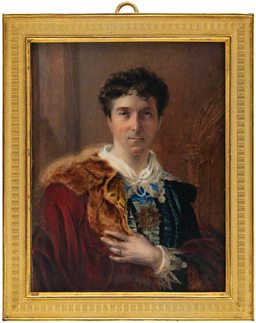
Eton-educated Mr Young was a big star, you can sense from this 1830 playbill from the British Library collection. It's clear that the manager of the Theatre Royal is proud to have secured his services in three roles.
The Danish Prince was the one in which Young shone most brightly
The Danish Prince was the one in which Young shone most brightly, in a performance unsurpassed or according to the playbill 'unrivalled' by other notable actors.
His first London appearance in the role of Hamlet was in 1807. As his reputation grew so did a rivalry between Young and the equally famous but more established actor Edmund Kean, who reportedly liked the odd drink.
It all came to a head in 1822 when Young was hired to play Iago opposite Kean as Othello at the Drury Lane theatre in London.
In a letter at the time Kean writes indignantly: “…is Mr Young to act Iago with me….did Mr Young’s Hamlet ever bring to the treasury the same Money that mine has: is there any Country manager (that) will give Mr Young £10 for his acting Hamlet (?)…I am prepared for war….” And he professes to be tired of pimps and sycophants.
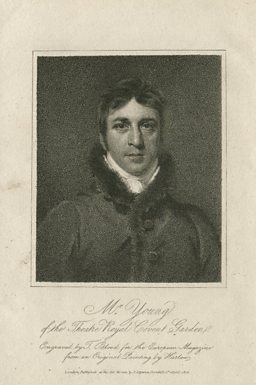
There was no escaping the on stage showdown at Drury Lane. Playbills were posted all over London, it was described as a night of 'mighty expectation' and like any prize fight the reviewers concentrated on the differing physical characteristics of the players.
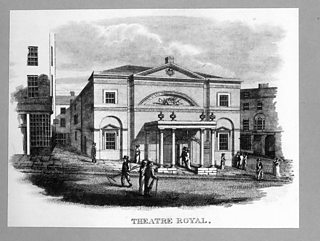
In one corner, the working class fighter, in another the well-educated aristocrat. Although both had merits, in the end the 'fierce, ungovernable, dangerous' Kean is held by most, but not all, to be the victor.
Young, it’s reported, was not at all disappointed with the outcome – nor presumably was the theatre as the clash would have been box office dynamite!
In the future Kean was to avoid opportunities to be compared with his rival.
During one of his tours, Kean discovered that Young is scheduled to play the same part after the other actor had finished the run of performances.
Kean sees red and says if this goes ahead he will not fulfill his engagement. Eventually, the theatre backs down.
Later Mr Young left Drury Lane and here we catch him appearing in Newcastle. Perhaps the encounter with Kean and intervening years added a complexity to his interpretation of Prince Hamlet.
Certainly the author of this playbill is convinced he’s a box office draw as he prepared to pay the price for having a star of such status.
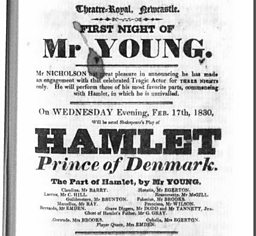
About Shakespeare on Tour
From the moment they were written through to the present day, Shakespeare’s plays have continued to enthral and inspire audiences. They’ve been performed in venues big and small – including inns, private houses and emerging provincial theatres.
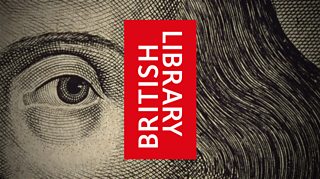
BBC English Regions is building a digital picture which tracks some of the many iconic moments across the country as we follow the ‘explosion’ in the performance of The Bard’s plays, from his own lifetime to recent times.
Drawing on fascinating new research from Records of Early English Drama (REED), plus the British Library's extensive collection of playbills, as well as expertise from De Montfort University and the Arts and Humanities Research Council, Shakespeare on Tour is a unique timeline of iconic moments of those performances, starting with his own troupe of actors, to highlights from more recent times. Listen out for stories on Shakespeare’s legacy on your BBC Local Radio station from Monday 21 March, 2016.
You never know - you might find evidence of Shakespeare’s footsteps close to home…
Craig Henderson, BBC English Regions
Did Young make an appearance in the French Revolution that same year?
An interesting footnote to Mr Young’s career is that there are reports of a gentleman by his name, an actor, who was caught up in the French Revolution of 1830. Whether he was appearing in a professional capacity it’s difficult to ascertain but on his way back from Paris, he made several rousing speeches – in his own, not Shakespeare’s words - which were greeted by cries of “Vive l’Anglais!”
Back in England he retired, two years later in 1832, with a farewell performance playing Hamlet. He died in 1856.
-
![]()
Shakespeare Lives
The nation’s greatest performing arts institutions mark 400 years since the Bard's death
Related Links
Shakespeare on Tour: Around Newcastle
-
![]()
Child prodigy actor prepares to retire as he headlines in Newcastle
W.R. Grossmith says farewell to the stage at 11
-
![]()
Heavyweight Shakespearean actor's huge influence on north east theatre
The legacy of Stephen Kemble, actor turned theatre manager
-
![]()
The Royal Shakespeare Company's links with Newcastle
Nearly four decades of cooperation between Newcastle and the RSC
Shakespeare on Tour: Around the country
-
![]()
Ipswich: a magnet for Shakespeare?
Why did Shakespeare's company visit Ipswich ten times?
-
![]()
Sarah Siddons visits Norwich
Putting the Theatre Royal, Norwich, on the map
-
![]()
Madame Tussaud's exhibiton in Nottingham
Including a model of William Shakespeare
-
![]()
Touring Kent to avoid the plague
In 1592, the plague forced touring theatre companies out of London










